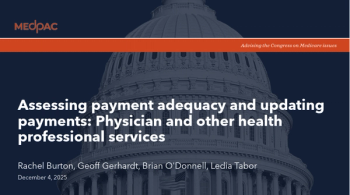
- February 10, 2019 edition
- Volume 96
- Issue 3
How to survive high-deductible health plans
Successful practices will review and establish new financial policies, do a better job of educating patients, and consider cash-pay services.
More Americans are choosing high-deductible health plans for their lower monthly premiums, though this results in steeper out-of-pocket costs for care. According to the Centers for Disease Control and Prevention (CDC), in 2017 42.3 percent of insured patients were enrolled in high-deductible health plans, up from 39.4 percent in 2016. This leaves some physicians scrambling to collect payments and manage shrinking cash flow.
What can physicians do to improve their cash flow in this new landscape? Experts suggest that successful practices will review and establish new financial policies, do a better job of educating patients, and consider cash-pay services.
Put policies into place
Many physician practices erroneously assume their patients know and understand their financial obligations and insurance details, according to David Zetter, CHBC, a healthcare business consultant in Mechanicsburg, Pa.
“Most practices don’t have patients sign a financial policy, so most patients have no clue what the practice expects,” Zetter says.
Physicians need to set policies on getting money up front, he says. He usually recommends a practice rewrite their financial policies to include steps such as: charging a late or no-show fee; requiring all patients to have a credit or debit card on file; or always taking a flat deposit upon booking an appointment, that can later be credited back to the copay once the patient’s percentage is determined.
“If the business isn’t taken care of first, you’re not going to be able to take care of patients, because you won’t be able to afford it,” Zetter says. He also recommends that every patient be required to have a phone meeting with a patient financial counselor, which can be an office staff person, who reviews the practice’s financial policies and gets the patient to sign the practice’s agreement to the financial policies.
“I’ve got clients that won’t even accept patients if they don’t have a debit or credit card. They don’t have an accounts receivable problem,” Zetter explains. Other practices he’s consulted with have strict policies where patients can’t be seen until they catch up on outstanding payments.
Educate your patients
Tisha Rowe, MD, a primary care physician in private practice in Houston, Texas, says that it’s up to the practice to help patients understand their financial responsibility.
“Whether that’s highlighting that portion of their [explanation of benefits] in writing or maybe creating a short video that spells it out, you want to make sure patients know their deductible and what a visit costs them,” Rowe says.
She’s had many incidents where patients were upset with her for being charged around $100 for something as simple as a medication refill where they had to come in office. However, the cost of the visit is related to what percentage of the deductible the patient has to pay. “I can’t change the price because [the patient] hasn’t met their deductible,” she says. “So we have to educate our patients.”
Rowe creates simple videos she uploads to a YouTube channel on topics such as telemedicine and wellness tips, each no longer than a couple of minutes. “You’re going to repeat that same information twenty times per day. Just put it out there, and make it accessible, and you can have partners share it,” she says, adding that even if a physician is not tech savvy or doesn’t have the time, it’s not complicated to get help creating them.
Consider an insurance/concierge hybrid
With deductibles increasing to all-time highs, Rowe says people who are not managing a significant illness or expecting surgery are unlikely to ever meet their health plan’s deductibles. Her practice has a hybrid concierge plan for these patients.
If she sees a patient for a physical and labs, they may end up paying $1,000, she says. However, she says, if a patient signs up for her concierge plan for $100 per month, the patient knows exactly what services they’re getting, and get better access, as well.
She says that physicians shy away unnecessarily from concierge or self-pay plans because they believe that only wealthy people can afford them. In her practice, she says, most of her concierge patients are working-class people.
Rowe contends that people who use a high deductible health plan can afford a concierge doctor because they’re unlikely to ever meet their deductible anyway. “I guarantee you’re not going to see that much in medical care most years,” she says.
Paula Muto, MD, FACS, a vascular surgeon in Lawrence, Mass., and the founder of UberDoc, which helps patients find specialists, agrees that doctors should have some form of self-pay offering because it works in both the physician’s and the patient’s favor. “It is usually cheaper for a patient with a high deductible to pay cash for a procedure. You’re never going to reach your deductible anyway.”
Physicians get paid immediately without going through the hassles of billing, coding, or denials, she points out. Muto suggests cash pay also creates greater transparency. She says that bringing it back to cash leads the physician talk to the patient honestly not just about their care itself but about the cost of their care. “If deductibles are here to stay, we must be transparent,” she says.
Take a deposit and/or get a credit card on file
Another way to increase the likelihood of getting paid is to request a flat rate deposit on all appointments. Destiny Biggs, RN, practice manager for MedNow Urgent Care in Augusta, Ga, says that her practice requires a $75 deposit and a credit card on file for all patients with a high-deductible plan.
Additionally, if a patient comes in and has an outstanding balance, the balance is due at the time of service. “They don’t get to say, ‘I’ll pay it next week,’” Biggs says.
Just having a credit card on file has made a tremendous difference in their collections. Whatever the patient owes beyond the $75 deposit is charged at the time of service, and the patient is alerted at the same time. “With credit cards on file, we collected [an additional] 15 percent of our patient balances last year or this current year,” Biggs says.
This puts a greater responsibility on front desk staff to be assertive in obtaining patient credit card information every time, so she says practices should be thoughtful when hiring for these positions or consider training them in this approach. At MedNow, the front desk staff sells the idea by reminding patients that putting a credit card on file means they won’t have to receive bills in the mail and/or make payments later.
Think twice before you diagnose
For James Wilk, MD, an internist who works for the University of Colorado in Denver, high-deductible plans have changed the way he orders diagnostic tests.
He admits that he didn’t know the cost of some of the tests he orders until patients complained about financial hardship, or worse, refused to get the tests, leading to worsening or untreated conditions. “So this person is walking around with probable but undiagnosed asthma because the cost of the test is so high that they couldn’t get it,” Wilk explains.
“I think twice about how necessary some diagnostic workups are. Instead of doing a bunch of tests, sometimes I’ll just plan a three- or four-step kind of thing. That way, if we make the diagnosis, we don’t have to test for twelve things, which would cost a fortune.”
He makes sure to inform his patients that he is ordering tests in the most cost-effective way possible. “They usually thank me for being conscientious of that,” Wilk says.
While this is not his ideal way of practicing medicine, he understands that patients are facing increasing financial pressure and encourages patients to work with financial counselors so that they don’t put off necessary treatment or tests.
Use big data and AI to determine propensity to pay
High deductibles may not be the only reason that patients are struggling to pay their doctor bills, according to Florian Otto, MD, co-founder of Cedar, a healthcare technology consulting business based in New York City.
He says that simply ranking patients by their propensity to pay may not be very effective because there may be multiple reasons ranging from:
- They don’t have enough money
- They don’t check their mail often
- They don’t speak English
- The bill is incorrect/ not what they expected and patients don’t know how to get a corrected bill
He recommends that practices use artificial intelligence-based programs that draw from basic demographic information and user data to assess more accurately why patients aren’t paying. For example, he says, if a patient received their bill digitally and clicked on it three times but never paid, it might warrant sending a text asking if they are having trouble understanding the bill, and then connects them to a live chat function.
Additionally, he says, physicians should automate the billing process to make it easier for patients to pay. “We strongly believe that it shouldn’t take longer than 20 to 30 seconds to pay your bill, similar to the Amazon Prime experience,” Otto says.
Patients just want an easy, convenient and quick way to pay, he says, and it’s up to physicians to offer these.
“Reducing friction makes happier patients, and also increases cash flow,” Otto says.
Articles in this issue
almost 7 years ago
Working with non-physician providersalmost 7 years ago
Replacing doctorsalmost 7 years ago
Trump's drug price planalmost 7 years ago
A physician’s guide to preventing data breachesalmost 7 years ago
Who will own your exam room?Newsletter
Stay informed and empowered with Medical Economics enewsletter, delivering expert insights, financial strategies, practice management tips and technology trends — tailored for today’s physicians.















